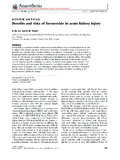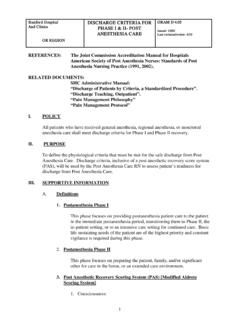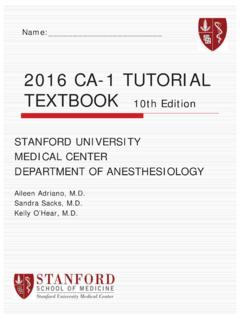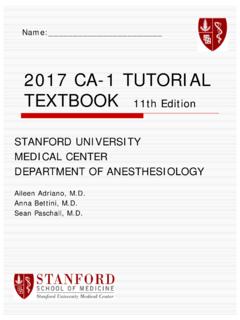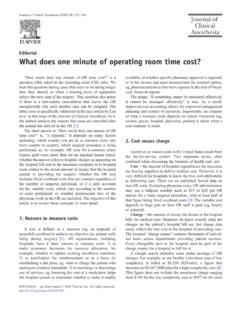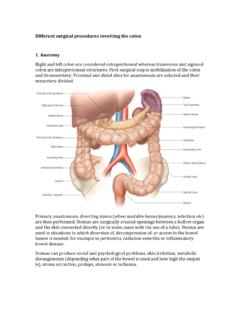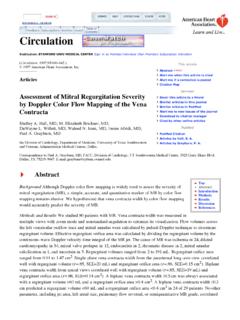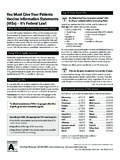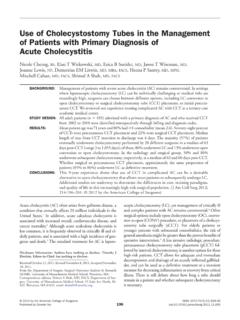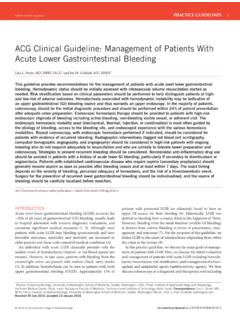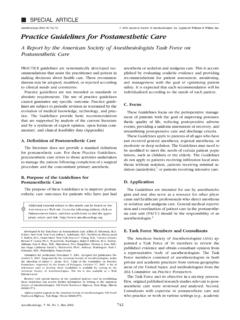Transcription of Neuraxial Techniques in Obstetric and Non-Obstetric ...
1 Regional AnesthesiaSection Editor:Terese T. HorlockerNeuraxial Techniques in Obstetric and Non-ObstetricPatients with Common Bleeding DiathesesStephen Choi, MD*Richard Brull, MD, FRCPC* BACKGROUND:There are few data in the literature regarding the safety of neuraxialtechniques in patients with the most common bleeding diatheses, includinghemophilia, von Willebrand s disease (vWD), and idiopathic thrombocytopenicpurpura (ITP). Neuraxial Techniques are not widely used in these populationsbecause of concerns of potential hemorrhagic and/or subsequent neurologiccomplications. In this article, we review the available literature describingneuraxial Techniques in patients with hemophilia, vWD, or ITP with the aim toassist anesthesiologists considering Neuraxial Techniques in these :After a systematic Pubmed, MEDLINE, and EMBASE search, we re-viewed 30 articles published between January 1, 1975 and October 1, 2008 in whichneuraxial Techniques were performed in patients with hemophilia, vWD, or ITP todetermine the perioperative management and evaluate the frequency of hemor-rhagic.
2 We identified 507 Neuraxial Techniques (482 patients ) performed in pa-tients with hemophilia (107 Neuraxial Techniques , 85 patients ), vWD (74 neuraxialtechniques, 72 patients ), or ITP (326 Neuraxial Techniques , 325 patients ). Among the507 Neuraxial Techniques performed, there were 371 lumbar epidural anesthetics, 78spinal anesthetics, 53 lumbar punctures, 2 combined spinal epidural analgesia, 2paravertebral blocks, and 1 thoracic epidural anesthetic. Four hundred six neuraxialtechniques were placed in the Obstetric population, 53 were performed in theemergency room for diagnostic lumbar puncture, 46 were performed for lower limborthopedic surgery, 1 was performed for postoperative analgesia, and 1 was per-formed for an Obstetric patient undergoing Non-Obstetric surgery.
3 Factor replacementto normal levels ( IU mL 1) was initiated before block performance, thoughtreatment was not standardized, in 105 of 107 patients with hemophilia and 10 of 74with vWD. Sixty-four of the 74 patients with vWD had spontaneous normal-ization of factor levels before block performance. No hemorrhagic complica-tions were reported when the diagnosis of hemophilia or vWD was knownbefore the Neuraxial technique . A single case of spinal hematoma (resulting inpermanent paraplegia) was identified when the presence of hemophilia was notknown before needle insertion and factor replacement had not been given.
4 In all326 cases of ITP, with or without systemic treatment of platelet transfusion,there were no reports of hemorrhagic complications associated with neuraxialtechniques. Among the 326 Neuraxial Techniques placed in the setting of ITP, 9patients had platelet counts of 50 109L 1, 19 had a platelet counts of50 75 109L 1, 204 had a platelet counts of 75 100 109L 1, and 94 had aplatelet count more than 100 109L 1before needle :There is a paucity of published data regarding the provision andsafety of Neuraxial Techniques in patients with common bleeding diatheses. Theminimum safe factor levels and platelet count for Neuraxial techniquesremain undefined in both the Obstetric and general populations, and evidence-based recommendations in the setting of hemophilia, vWD, or ITP cannot beoffered.
5 (Anesth Analg 2009;109:648 60) Neuraxial blockade provides multiple benefitswhen compared with general anesthesia and/or sys-temic analgesia, including superior postoperativeanalgesia,1decreased opioid-related side effects, im-proved rehabilitation,2and reduced morbidity 7 The advantages of Neuraxial techniquesin Obstetric anesthesia are, further pronounced withFrom the *Department of Anesthesia, University of Toronto; and Department of Anesthesia and Pain Management, Toronto WesternHospital, University Health Network, Toronto, Ontario, for publication March 9, correspondence and reprint requests to Dr.
6 RichardBrull, Department of Anesthesia and Pain Management, TorontoWestern Hospital, University Health Network, 399 Bathurst Street,Toronto, Ontario, Canada M5T 2S8. Address e-mail to 2009 International Anesthesia Research SocietyDOI: 109, No. 2, August 2009648significant reductions in maternal morbidity and mor-tality, and improved pain relief and patient 15 Consensus guidelines published by theAmerican Society of Regional Anesthesia and PainMedicine (ASRA) and the German Society of Anesthe-siology and Intensive Care are available for anesthe-siologists considering Neuraxial Techniques in patientsreceiving hemostasis-altering ,17 How-ever, there is little evidence in the literature regardingthe application of Neuraxial Techniques in patientswith common bleeding diatheses.
7 These patients maysafely and successfully undergo major surgery undergeneral anesthesia provided that the defect is ad-equately 29 The objectives of this revieware to examine and summarize the reported periop-erative management and assess the frequency ofhemorrhagic complications in patients with themost common bleeding diatheses (hemophilia, vonWillebrand s disease [vWD], and idiopathic throm-bocytopenic purpura [ITP]) with the aim to assistanesthesiologists considering Neuraxial techniquesin these systematic search of the PubMed, MEDLINE,and EMBASE databases was performed using themedical subject heading words regional anesthesia, Neuraxial blockade, epidural, spinal, sub-arachnoid, intrathecal, lumbar puncture, para-vertebral, steroid, and caudal.
8 Search resultswere then cross-referenced with each of the medicalsubject heading words coagulopathy, hemophilia, von Willebrand, thrombocytopenia, ITP, Im-mune, and Idiopathic. Only studies in whichneuraxial Techniques were performed on patients withthe aforementioned bleeding diatheses were forms of hemophilia were excluded. Thereferences of all relevant publications were examinedto capture any additional material suited for thepresent review. The quality of evidence for eachidentified article was independently graded by each ofthe authors (highest to lowest I V) according to thecriteria described by Wright et al.
9 (Appendix).30,31 Where possible, the pre-and posttreatment coagula-tion variables, platelet counts, treatment administered,needle gauge/type used for the block, difficulties notedwith placement, and thesource authors recommenda-tions regarding management of the bleeding diatheseswere included in the summary tables. Complicationswere defined as hemorrhage related to the neuraxialtechnique procedure with or without subsequent neu-rologic search yielded 86 articles of which 30 met ourinclusion criteria. The quality of evidence score for the30 source articles in this review was Level IV (Appendix).
10 Sixteen of the 30 articles cited were case 47 Fourteen of the 30 articles were case 61 Tables1 3 summarize the articles according to bleedingdefect and by type of Neuraxial six articles, we identified 107 neuraxialtechniques performed on 85 patients with hemophilia,and there were no reports of spinal hematoma whenthe diagnosis of hemophilia was known before ,37,38,51,52,58Of these 107 Neuraxial tech-niques, there were 53 diagnostic lumbar punctures inthe emergency room, 35 spinal anesthetics for lowerlimb orthopedic surgery, 11 lumbar epidural anesthet-ics for lower limb orthopedic surgery, 7 lumbar epi-dural anesthetics for labor, and 1 lumbar epiduralanesthetic for abdominal surgery.
